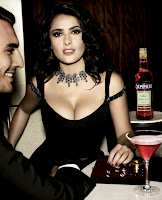
The apple brandy sitting in my small barrel has been there longer than any spirit before it. It's been almost five and a half months now, and there's a reason that it's been there for so long.

If you'll recall, I added a mixture of several products to the barrel this time around: Laird's Straight Apple Brandy, Captain Applejack, and
sweet apple wine. Once the mixture rested in the barrel for a few weeks/months, what began to happen was something that I feared. The crisp fruitiness of the applejack began to take over the rest of the flavors, somehow. What had been an overwhelming flavor of apples was slowly becoming a somehow nondescript fruity tone, bordering on almost an artificial grape flavor. It's hard to describe.
Luckily for me, time was the remedy. As late as one month ago, that generic fruitiness still prevailed. But now, almost 6 months after the aging began, the mix has finally mellowed, and the result is great.
The ReviewComposite Apple Brandy, at-home agedIn the Glass
I was surprised to see the brandy actually had legs that would stick to the glass as I slowly swirled it around. Clearly, the wood from the barrel has given it a bit of body and viscosity. The wood also gave it color; the apple brandy's dark hue is somewhere between bourbon and a heavily aged rum.
SmellJust like the other results of the
Cask series, the smell is all wood. But somehow, it's a different kind of wood. The
rum and the
brandy gave off an aroma of being in a wood shop, but the apple brandy smells almost like a bourbon, with a much more distinct and dark, earthy character. After a few moments of trying, I can finally sense the apples, and then faint vanilla,
as barrels are so wont to give.
TasteI was again surprised to learn that despite the apple brandy's modest legs in the glass, the texture and mouth feel were thin. The angel's share in this batch hadn't been
as devastating as times passed, so perhaps this is something that I should have expected. The spirit is also pretty hot... my guess is over 80 proof, maybe even over 100.
The first thing that my tongue thinks is "sweet". When the sweetness finally subsides, I get a rich apple flavor, which is admittedly short lived, because the sweetness again takes over. There's no smokiness at all, which this barrel sometimes imparts. The end of the sip gives you a nice dry (even tannic) woodiness that's not surprising, considering how long the brandy aged. The aftertaste is nice and long, with only sweetness and warmth.
Ice CubeSomehow, the only thing that ice/water does to this spirit is makes it even more sweet. The mouth feel and flavor do not change... only the sweetness.
MixingThere's not much I would mix this stuff with. As a considerably old spirit, there's much more merit in complementing it rather than having it complement. As if you couldn't see it coming, I made a composite apple brandy Old Fashioned. I used
Fee Brothers Whiskey Barrel Bitters, and instead of citrus peel, I used a cinnamon stick for a garnish. It goes without saying that the result was very, very palatable.
 Conclusion
ConclusionThe barrel showed me that it's still "got it". Its ability to age might be slowing, but it's nowhere near depleted. The maturity of the apple brandy is bordering on the barrel's original passenger, the
Wasmund's Rye Spirit. I'm pleased and encouraged.
So what's next? Something a bit unusual, that's what.
 About a year ago
About a year ago I spoke of my fondness of Seagram's gin, but I also pointed out that they have
flavored gins that are hard to take seriously. Well, one of these gins is flavored with red apples. Red apples and gin is such an interesting combination that I'm inspired to take this opportunity to make my own apple gin(sort of).
I'm not going to rinse the barrel of excess apple brandy... I'm not even going to let it air out. Fresh and dripping from evacuating the brandy, a handle of Gordon's gin is going in. (
Hey, if it's good enough for James Bond, it's good enough for me.) Gordon's is a good middle of the road brand, I'd recommend it if you find that you can't find the beauty in top shelf gins.
In contrast to the apple brandy's long aging time, I expect the gin's aging time to be short. Much like Seagram's gin, I only want a bit of color and flavor added to the gin from the barrel. I just want to "toast" it, if you will. My guess is two months or less.













